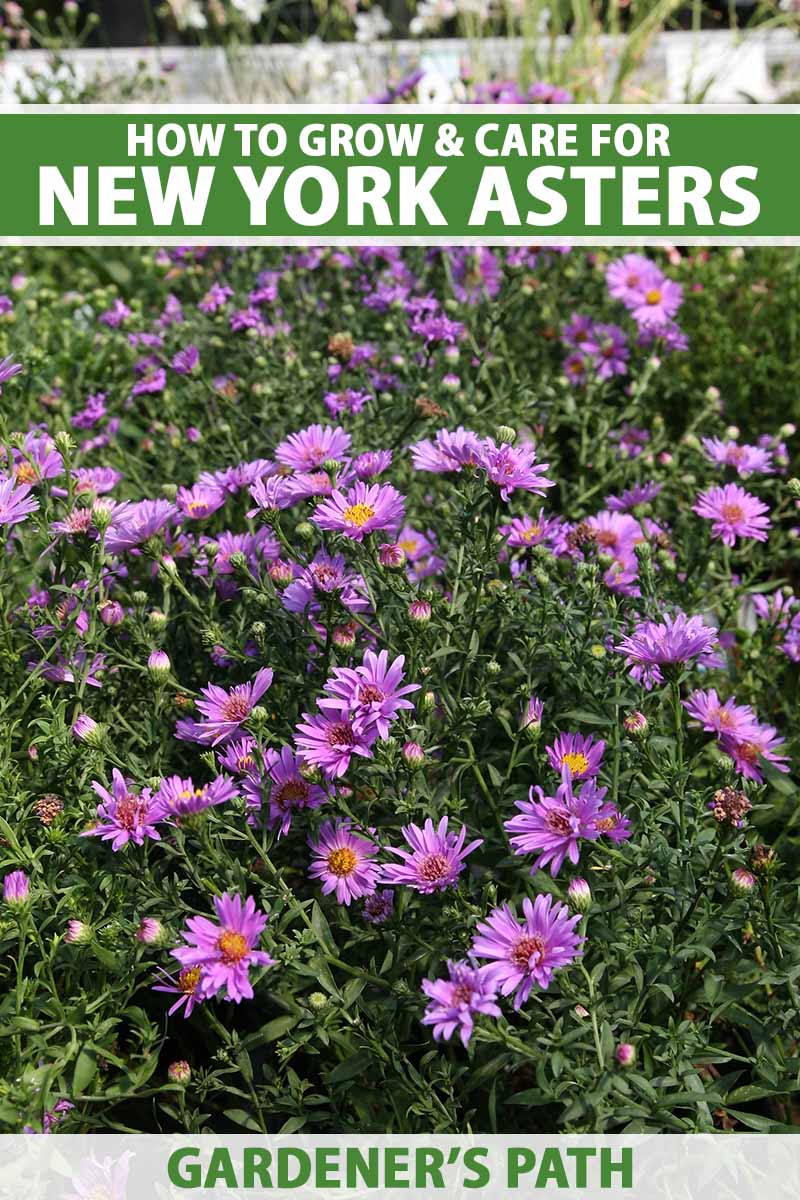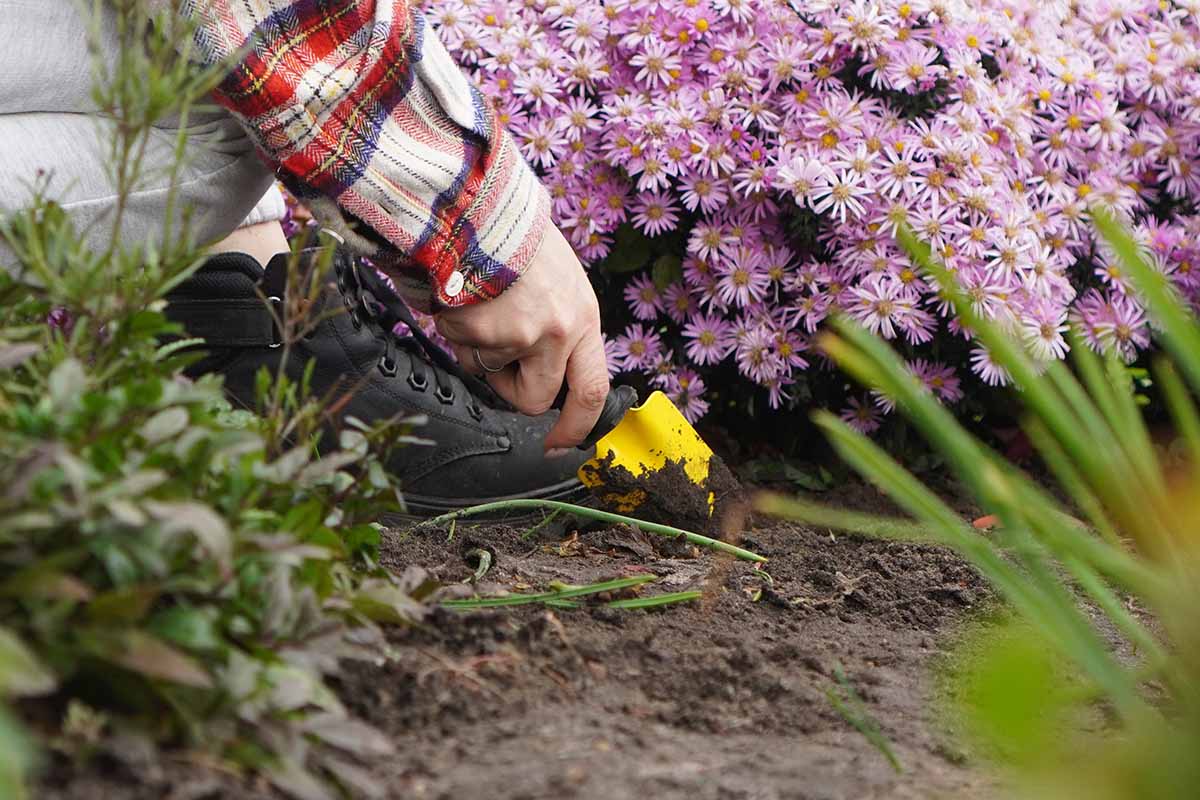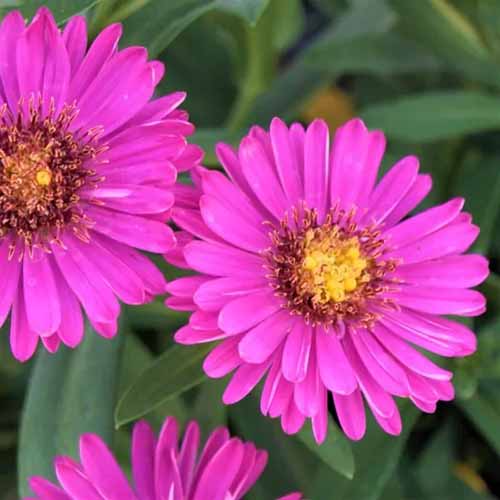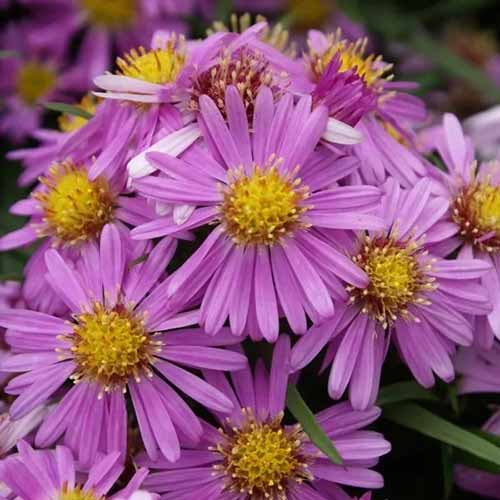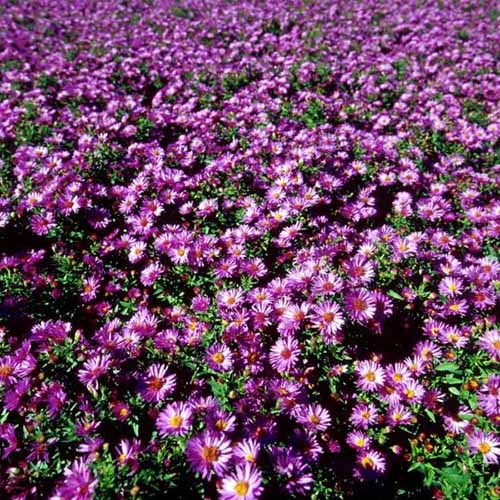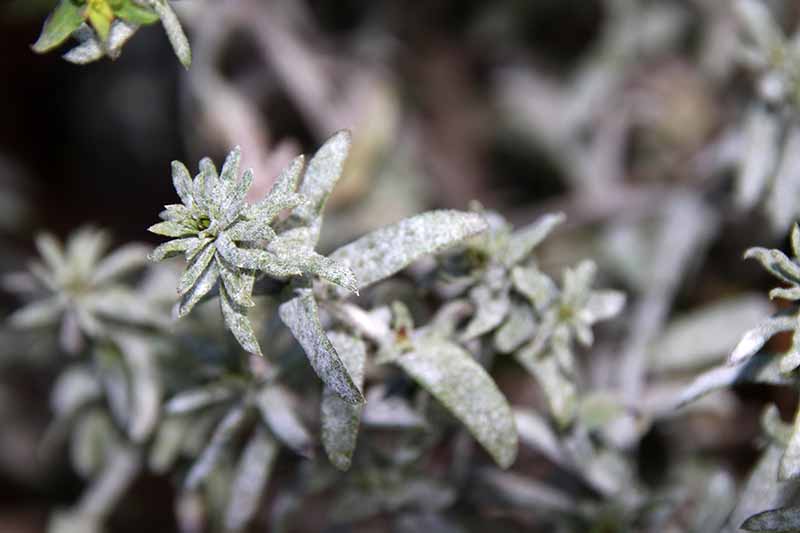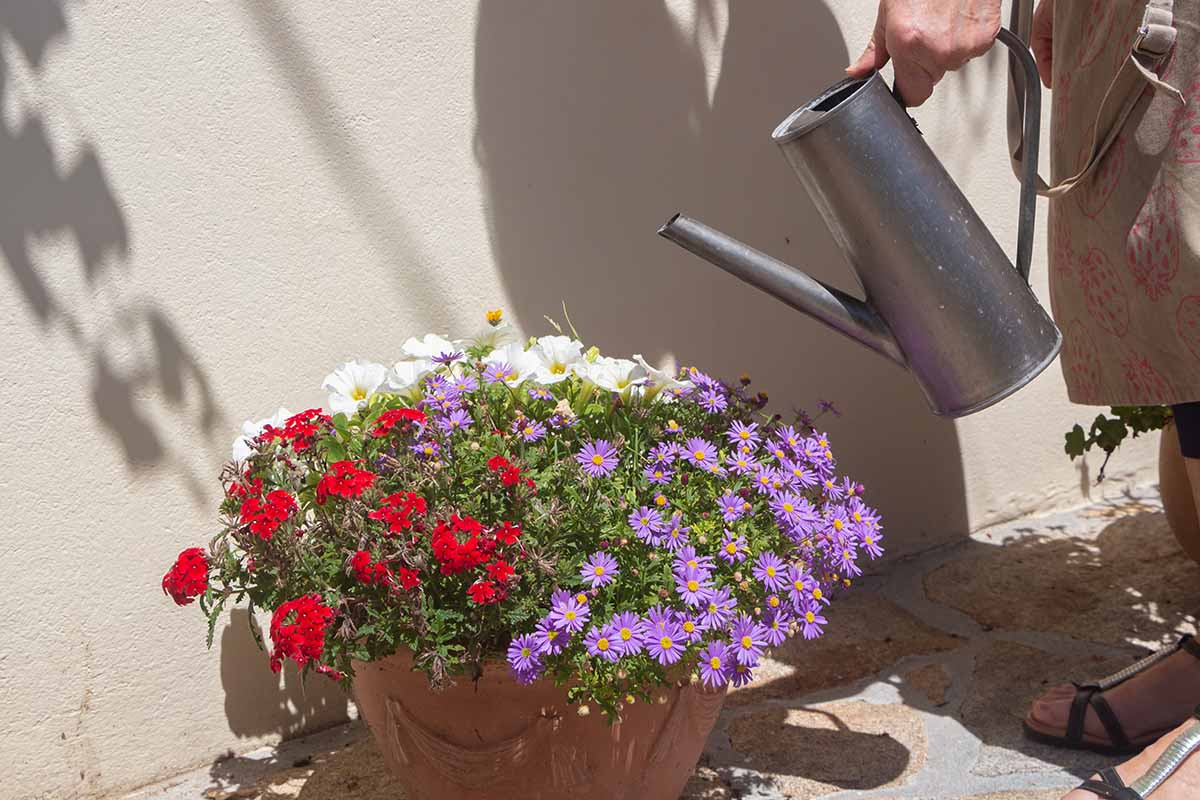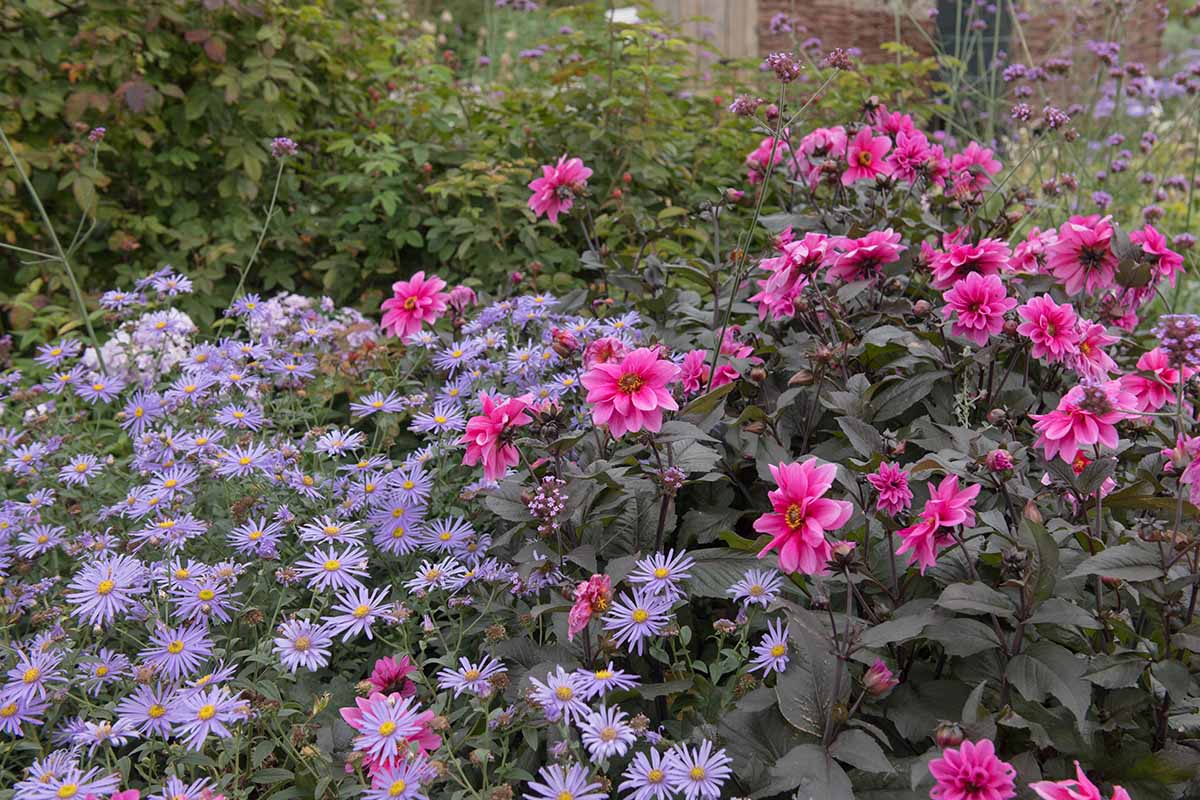We link to vendors to help you find relevant products. If you buy from one of our links, we may earn a commission. Our guide to growing asters provides an overview of species and cultivation. The focus of this piece is on how to grow and care for New York asters specifically. Ready to dive in? Here’s what we’ll cover: Let’s begin with an overview of the species.
What Are New York Asters?
The New York aster was formerly classified in the Aster genus. And while you’ll still come across it categorized in this way, it was officially reassigned to the Symphyotrichum genus in the 1990s, where it remains. And while we still call our native species asters, the New York variety also has a nickname, the Michaelmas daisy, because it blooms near the Christian feast day of Saint Michael on September 29. There are three varieties of the New York species found in the wild, S. novi-belgii var. novi-belgii, S. novi-belgii var. elodes, and S. novi-belgii var. villicaule. Varieties share the most significant traits of the species but may differ in minor characteristics or location, as is the case with the New York species. The first two varieties grow along the coast, and the third is endemic to stream banks along the Maine-Canada border. S. novi-belgii grows from one to six feet tall and spreads one to three feet wide in its wild form. It is suited to cultivation in USDA Hardiness Zones 4 to 8. These plants have a clumping growth habit, and alternating lance-shaped leaves line branching stalks. The stems and leaves are generally green to grayish-green but may have a burgundy tint. As they age, the lower leaves often turn yellow. The stalks have lateral branches. Each stalk develops one composite flower at its terminal end consisting of a yellow disk of florets surrounded by colored petal-like rays. Like many wild asters, the flowers measure about an inch in diameter. The species name, novi-belgii, means New Belgium, aka New Netherland, the name of present-day New York when it was a Dutch colony in the 1600s. New York asters resemble the New England species, S. novae-angliae, but subtle differences are distinguishable to the trained eye. The main one is that the New York species has smooth stems and leaves, and the New England type has hairy ones. However, as mentioned at the outset, home garden varieties of the New York flowers are usually hybrids, mainly developed by crossing them with bushy asters, S. dumosum, or smooth ones, S. laeve, both of which have hairless leaves and stems.
From Seed
You can grow true species plants from collected seed, but seeds from hybrids produce variable results that may not resemble the parent plant. Sometimes cross-bred flora produces seeds that are not viable, or no seeds at all. For even more details about the history of aster breeding, a wealth of varieties, and other info, check out “The Plant Lover’s Guide to Asters” by Paul and Helen Picton. The Plant Lover’s Guide to Asters Now that we have some background, let’s learn about propagation.
Propagation
It’s easy to start with seeds, stem cuttings, or transplants. Here’s a quick overview of each of the three methods. To grow true species from seeds: Start seeds indoors in late winter, or direct sow after the last average frost date. Fill a seed starter tray with potting soil. Place two seeds in each cell. Barely cover the seeds with one-eighth of an inch of potting soil. Place the tray in a sunny window. Keep the soil evenly moist. When the seedlings have two sets of true leaves, thin them to one per cell.
From Cuttings
A stem cutting replicates the characteristics of the parent. In late spring or early summer, make a clean cut across a stem about six inches from the tip. A clean cut is less likely to invite pests and disease than a ragged one. Snip the leaves off the bottom four inches of the stem. Place the bare stem in four inches of water. Change the water daily and keep all foliage above the water surface to avoid fouling it. Alternatively, dip the bare stem in rooting hormone and bury it four inches deep in a container of potting soil with a depth of at least six inches.
From Seedlings/Transplanting
Starting with a nursery plant is an excellent way to ensure that you are getting the variety you want, especially if you purchase it in late summer when it’s in bloom. Transplant a seedling, stem cutting, or nursery plant in late spring or early fall to avoid damaging frost and peak summer heat. Place plants in the ground at the same depth they were in their original containers to minimize transplant shock. For more detailed propagation instructions, see our guide.
How to Grow
Plants are suited to garden and container cultivation because the height variations achieved through hybridization make it easy to select certain sizes to suit your gardening needs. Cultural requirements for growing S. novi-belgii include full sun for best results, but plants can generally tolerate some afternoon shade. The soil should be organically-rich loam that is both moisture retentive and well-draining, with a pH of 5.1 to 6.8. These plants can adapt to clay and sandy soils, and occasional oversaturation and drought. Disease-resistant hybrids offer the best chance for success, as this smooth-leaf species and its cultivars are more prone to fungal conditions, like powdery mildew, than their hairy counterparts. One way to inhibit fungal diseases is with generous spacing to accommodate mature dimensions. Leaving one to three feet of space between them ensures that air circulates well to dry moisture on the leaves and soil surface, where mold spores can rapidly grow. Optimize performance with an inch of water per week, including rain, and apply a slow-release granular fertilizer at planting time and in early spring. Take care to avoid allowing the granules to touch plant tissue, and be sure to water over the fertilizer per package instructions.
Growing Tips
Begin with seeds, stem cuttings, or transplants, and remember the following:
Provide a location with full sun.Grow in moist, fertile soil that drains well.Provide an inch of water per week, including rain.Fertilize at planting time and every spring.If you have trouble getting your plants to bloom, check out our aster troubleshooting guide.
Once underway, there are some actions you can take to help your plants live their best life. Let’s learn what they are.
Pruning and Maintenance
Cultivars vary in height but are generally shorter than the six feet a native species can achieve. For those that top out at two feet or more, prune in early summer for a bushier, less leggy appearance. In early summer, use clean pruners to remove one-third of the total height. Instead of pruning, you can use twine and bamboo or metal garden stakes to support lanky stems. Also, prune off damaged, diseased, or pest-infested foliage. Compromised plant tissue invites pests and diseases. Make a clean cut across an affected stem at a distance of three inches from the bottom and discard infested or infected material in the trash. Maintain even moisture throughout the growing season. Weed regularly to eliminate competition for water and improve airflow. Remember to feed with a granular fertilizer each spring as the new shoots appear, and take care not to let the granules come in direct contact with tender plant tissue. Healthy plants spread via thick roots called rhizomes as well as seeds. It is easy for them to become overcrowded. To maintain adequate air circulation and avoid fungal diseases, divide asters every three years. Divisions make great gifts to fellow gardeners. And finally, after the first hard frost, cut all stalks down to a height of about two inches. Use clean, sharp shears to make smooth cuts. While it’s nice to have winter interest in the form of picturesque bare stalks and seed heads, a plant so prone to powdery mildew as this one should be completely cleared away and discarded to limit overwintering mold spores. If you have a fungal outbreak, throw the stalks away instead of putting them on the compost heap and consider rotating plants to a new location the following year. Loosely apply a two-inch layer of mulch over the cleared area for winter insulation and moisture retention. And now, on to some attractive cultivars! Some common pests to be familiar with include: Here are three vibrant choices to consider:
Alert
Suited to Zones 4 to 9, S. novi-belgii ‘Alert’ is a dwarf variety with bright pink flowers often described as red. Each has a double row of luscious rays surrounding a rich golden disk. Plants have a moderate rate of growth. ‘Alert’ Mature heights are a petite 12 to 15 inches with a modest spread of 15 to 18 inches, making this the perfect plant for containers or tidy beds. Leggy stems won’t be a problem with this type. ‘Alert’ plants are available from Nature Hills Nursery.
Professor Kippenburg
S. novi-belgii ‘Professor Kippenburg’ is suited to Zones 3 to 8. It boasts purple flower heads. And unlike the one-inch diameter of many asters, the Professor measures a generous one to two inches across, with double rays and a sunny center. ‘Professor Kippenburg’ Fast-growing plants achieve a height of 18 to 20 inches and a spread of 12 to 18 inches, making them well-suited to mid-story landscape placements. ‘Professor Kippenburg’ plants are available from Nature Hills Nursery.
Woods Pink
Fast-growing Aster x dumosus ‘Woods Pink’ is a hybrid that grows in Zones 4 to 8 and displays semi-double pink blossoms with classic yellow centers. ‘Woods Pink’ Plants have a height and width of 12 to 24 inches for a substantial swath of vivid low-profile color. ‘Woods Pink’ plants are available from Nature Hills Nursery.
Woods Purple
Aster x dumosus ‘Woods Purple’ is also well-suited to Zones 4 to 8, where its purple blossoms enrich the transitional landscape with much-needed color. ‘Woods Purple’ Like ‘Woods Pink,’ this variety grows fast and has mature dimensions of 12 to 24 inches tall and wide, making it an excellent choice for bedding. ‘Woods Purple’ plants are available from Nature Hills Nursery.
Managing Pests and Disease
Unfortunately, S. novi-belgii is prone to a host of pests and diseases.
AphidsChrysanthemum Lace BugsCucumber BeetlesLeaf MinersNematodesSlugs and SnailsTarsenoid Mites
Plant pollen-rich plants to attract beneficial insects that feed upon pests. You can use neem oil, an organic horticultural insecticide, to address most infestation issues. Diseases common to S. novi-belgii are:
Aster YellowsLeaf SpotPowdery MildewRustStem CankerWhite Smut
A sharp spray of the hose may dislodge pests. An application of organic insecticidal neem oil may also be effective. Preventative measures, such as ensuring adequate airflow between plants and not over- or underwatering, help keep fungal conditions at bay. Some may respond to fungicidal treatment. And as mentioned, powdery mildew is especially common. However, it generally affects the foliage and doesn’t disrupt blooming.
Best Uses
Today’s cultivars tame a tall wild aster for garden use. Dwarf varieties make a compact addition to beds and containers, whereas more statuesque versions provide an arresting sight when massed in a monochromatic drift or mixed wildflower meadow. Fellow late-season bloomers – black-eyed Susans, coneflowers, goldenrod, joe-pye weed, ornamental grasses, and other asters – look beautiful with S. novi-beglii. Mix them attractively in butterfly, cottage, and cutting gardens, where they feed local bees, butterflies, and songbirds. And if you’ve been searching for late-season color for a salty, sandy coastal setting or perhaps a moist rock garden, New York asters may be what you’ve been hoping to find. Keep in mind that the lower leaves of asters usually turn yellow and drop as the growing season wears on. The placement of shorter flora in front of them helps to hide this natural but often unsightly phenomenon. After waiting patiently in the wings all summer long, the landscape becomes their stage, providing a foliar backdrop to earlier bloomers. Add the New York variety to your garden planner. And as the curtain draws to a close for the season, rest assured they’ll return for an encore performance each year for many to come. Do you grow this flower at your house? Tell us about it in the comments section below. And for more information about growing asters in your garden, add these articles to your reading list next:
13 of the Best Companion Plants for Tall Late Season Asters11 Perennial Aster Species for Summer’s Last HurrahHow to Grow and Care for Calico Aster in the Late Summer to Fall Garden
